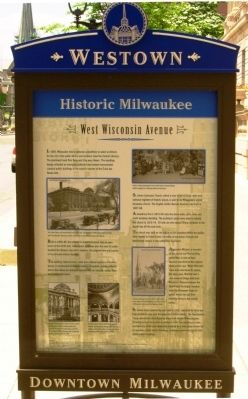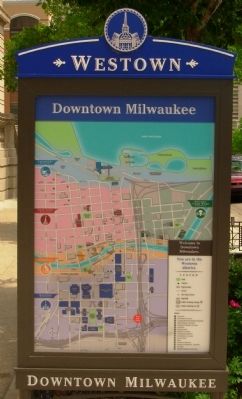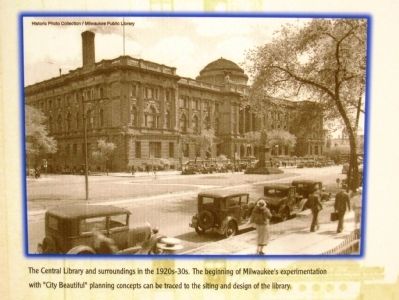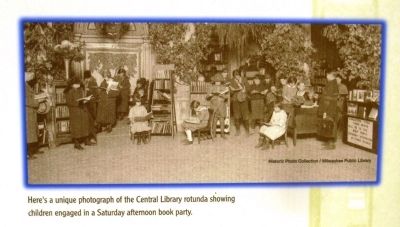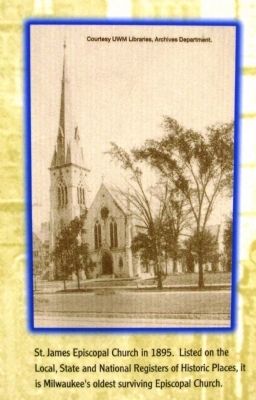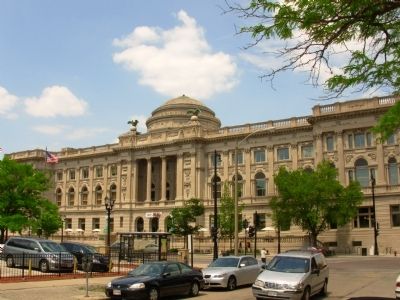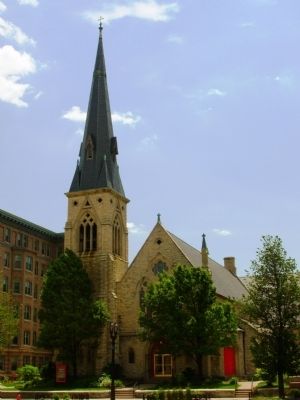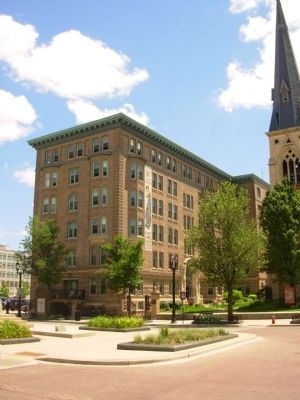Westown in Milwaukee in Milwaukee County, Wisconsin — The American Midwest (Great Lakes)
Historic Milwaukee
West Wisconsin Avenue
Built in 1895-99, the original U-shaped structure had an open court on the north end. Subsequent additions over the next 50 years doubled the library’s size while retaining the original form and beauty of its principal historic façades.
The building, listed on local, state and national registers of historic places, is constructed of Bedford Indiana limestone. A large coffered dome rises above an entrance rotunda with an intricate mosaic floor and marble staircases.
St. James Episcopal Church, which is also listed on local, state and national registers of historic places, is said to be Milwaukee’s oldest limestone church. The English Gothic Revival structure was built in 1867-68.
A disastrous fire in 1872 left only the stone walls, spire, bells and north windows standing. The architect’s plans were used to rebuild the church in 1873-74. Of note are two signed Tiffany windows in the fourth bay off the east aisle.
The church was built on the site of an old cemetery. While bodies were moved to Forest Home Cemetery, a few burial mounds and tombstones remain in the unfinished basement.
Alexander Mitchell, a member of the church and the building committee, is said to have donated one-third of the original construction cost. When Mitchell’s niece was married at St. James, the story goes, Mitchell had a rose-covered bridge built over Wisconsin Avenue between the church and his family mansion (now the Wisconsin Club) so guests would not soil their wedding finery in the muddy street.
St. James Court apartments was built in 1903, designed by the Ferry and Clas architects, who also designed the Central Library. The Neoclassical luxury apartments were home to many well-known Milwaukeeans, including one of the architects, Alfred C. Clas. The building is a rare example of a multi-unit residential building by a firm better know for its luxurious single family dwellings, imposing commercial blocks and grand public buildings.
Topics. This historical marker is listed in this topic list: Notable Buildings. A significant historical year for this entry is 1893.
Location. 43° 2.335′ N, 87° 55.335′ W. Marker is in Milwaukee, Wisconsin, in Milwaukee County. It is in Westown. Marker is at the intersection of West Wisconsin Avenue and North 8th Street, on the right when traveling west
on West Wisconsin Avenue. Located in front of Milwaukee Central Library. Touch for map. Marker is at or near this postal address: 814 W Wisconsin Ave, Milwaukee WI 53233, United States of America. Touch for directions.
Other nearby markers. At least 8 other markers are within walking distance of this marker. Central Library (a few steps from this marker); Saint James Court (within shouting distance of this marker); a different marker also named Historic Milwaukee (about 300 feet away, measured in a direct line); Milwaukee's Last Operating Tower Clock (about 600 feet away); B'Ne Jeshurun Synagogue (approx. 0.2 miles away); MacArthur Square (approx. 0.2 miles away); Mabel Wanda Raimey (approx. 0.2 miles away); a different marker also named Historic Milwaukee (approx. 0.2 miles away). Touch for a list and map of all markers in Milwaukee.
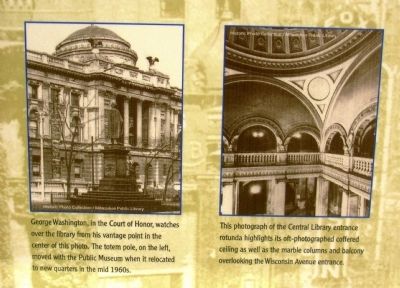
Photographed By Paul Fehrenbach, June 8, 2012
4. Close up of lower peft photos
Left photo: George Washington, in the Court of Honor, watches over the library from his vantage point in the center of this photo. The totem pole, on the left, moved with the Public Museum when it relocated to new quarters in the mid 1960s.
Right Photo: This photo of the Central Library entrance rotunda highlights its oft-photographed coffered ceiling as well as the marble columns and balcony overlooking the Wisconsin Avenue entrance.
Credits. This page was last revised on February 16, 2023. It was originally submitted on June 14, 2012, by Paul Fehrenbach of Germantown, Wisconsin. This page has been viewed 739 times since then and 20 times this year. Photos: 1, 2, 3, 4, 5, 6, 7, 8, 9. submitted on June 14, 2012, by Paul Fehrenbach of Germantown, Wisconsin. • Bernard Fisher was the editor who published this page.
